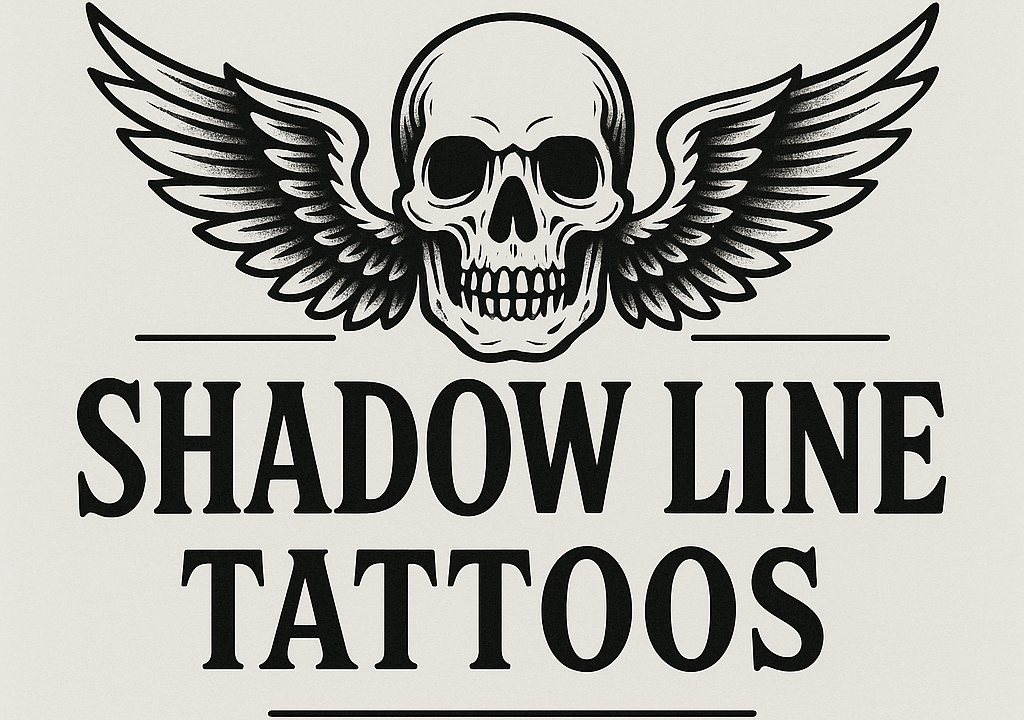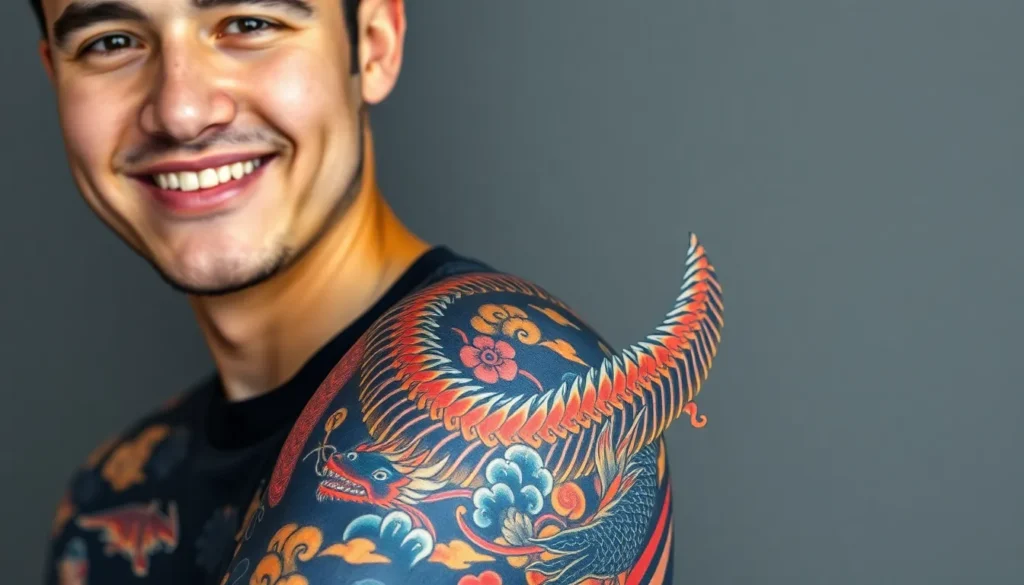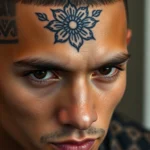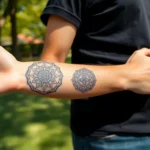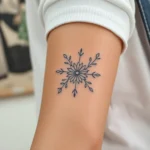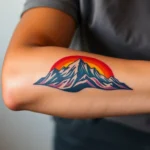Japanese sleeve tattoos represent one of the most captivating and meaningful forms of body art in the industry. These intricate designs tell stories through powerful imagery that’s been perfected over centuries of artistic tradition. We’re drawn to their bold compositions featuring mythical creatures, natural elements, and spiritual symbols that create stunning full-arm masterpieces.
The beauty of Japanese sleeve tattoos lies in their ability to combine multiple elements into one cohesive narrative. From fierce dragons and protective tigers to delicate cherry blossoms and flowing water, each design carries deep cultural significance while creating visually striking artwork that commands attention.
Whether you’re considering your first major tattoo or adding to an existing collection, Japanese sleeve designs offer endless possibilities for personal expression. We’ll explore the most popular motifs, their meanings, and how different elements work together to create these breathtaking artistic statements that honor Japan’s rich tattooing heritage.
Traditional Dragon Japanese Sleeve Tattoo Designs
Dragons represent the most powerful and revered creatures in Japanese sleeve tattoo artistry. We see these magnificent beings as symbols of wisdom, strength, and protection that transform entire arms into breathtaking masterpieces.
Ascending Dragon Symbolism and Placement
Ascending dragons create ever-changing visual narratives that flow naturally with your arm’s contours. We position these majestic creatures to spiral upward from wrist to shoulder, symbolizing personal growth and triumph over adversity. The dragon’s head typically crowns the shoulder area while its serpentine body winds around the forearm and bicep.
Upward movement in dragon designs represents overcoming challenges and achieving success. We often incorporate the dragon’s claws grasping at clouds or celestial objects to emphasize this ascending energy. Traditional placement follows the muscle structure, allowing the dragon to appear as if it’s climbing your arm when you flex.
Movement direction carries exact meanings that enhance your tattoo’s symbolism. We design ascending dragons with their heads pointing toward the heart, channeling positive energy inward. This placement creates a powerful visual statement about personal transformation and spiritual elevation.
Water and Cloud Elements Integration
Water elements provide essential context for dragon sleeve designs, creating atmospheric depth and movement. We integrate flowing waves, swirling mist, and turbulent seas to complement the dragon’s presence. These aquatic features typically occupy 30-40% of the sleeve’s background space, providing visual balance without overwhelming the main subject.
Cloud formations add ethereal beauty while reinforcing the dragon’s celestial nature. We strategically place cumulus and wispy cloud patterns around the dragon’s body to suggest its ability to soar through heavens. Traditional Japanese cloud styles, called “kumo,” feature distinctive curved edges and layered appearances that contrast beautifully with the dragon’s scales.
Water and wind elements work together to create natural flow throughout your sleeve design. We use churning waters at the base transitioning to gentle clouds near the shoulder, mimicking how dragons move between earthly and heavenly realms. This progression tells a complete story of transformation and power.
Color Variations for Dragon Sleeves
| Dragon Color | Symbolic Meaning | Common Accents |
|---|---|---|
| Black | Wisdom, maturity | Gold highlights, silver scales |
| Red | Passion, strength | Orange flames, yellow eyes |
| Blue | Tranquility, protection | White clouds, silver water |
| Green | Nature, growth | Brown earth tones, gold details |
| Golden | Imperial power | Red accents, black outlines |
Black dragons command respect through their association with ancient wisdom and spiritual depth. We enhance these designs with metallic accents that catch light beautifully, creating stunning visual contrast against darker skin tones. Traditional black dragon sleeves often incorporate deep purple shadows and bright white highlights.
Red dragons embody fierce energy and passionate determination in Japanese tattoo tradition. We pair these vibrant creatures with complementary warm tones like orange flames and golden scales. Red dragon sleeves make bold statements about the wearer’s strength and unwavering spirit.
Blue and green dragons offer more subtle yet equally powerful aesthetic options. We design blue dragons with cool undertones that suggest calm strength and protective qualities. Green dragons connect with nature themes, often featuring earth tone backgrounds and botanical elements that create harmonious sleeve compositions.
Koi Fish Japanese Sleeve Tattoo Concepts
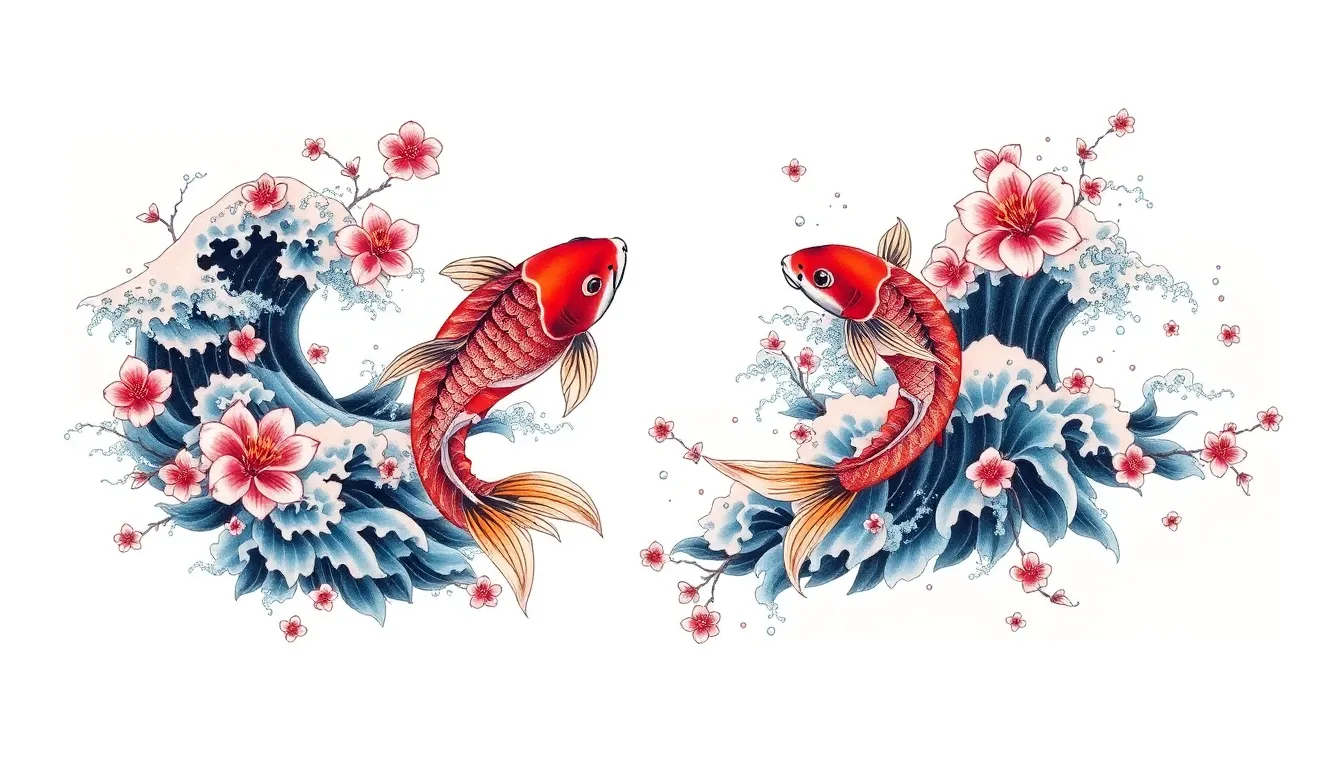
Koi fish tattoos symbolize perseverance and good fortune, making them powerful centerpieces for Japanese sleeve designs. These iconic creatures can be combined with complementary elements like waves, lotus flowers, and dragons to enhance both meaning and visual appeal.
Swimming Upstream Koi Designs
Swimming upstream koi designs emphasize strength and determination, representing the struggle to achieve success against adversity. Artists typically position these fish at ever-changing angles, creating movement that flows naturally with your arm’s contours. Water elements like ripples and waves highlight the koi’s upstream journey, adding texture and depth to the overall composition. Placement on the forearm or upper arm allows the swimming motion to follow your muscle lines, making the design appear more realistic and integrated with your body.
Waterfall and Cherry Blossom Combinations
Waterfalls paired with cherry blossoms create layered symbolism representing change, renewal, and life’s fleeting nature. These elements integrate seamlessly into sleeve designs, with cascading water flowing around koi fish while delicate cherry blossoms frame the composition. Artists position waterfalls to create vertical movement down your arm, while cherry blossoms add soft contrast through their organic shapes. This combination reflects the cycle of life, with the waterfall’s power balanced by the blossoms’ gentle beauty, creating a ever-changing yet harmonious piece.
Black and Gray vs. Colorful Koi Sleeves
Black and gray koi sleeves focus on shading and texture, creating dramatic effects through subtle nuances that appeal to those preferring minimalist or classic aesthetics. These monochromatic designs emphasize form and movement without color distractions, allowing intricate details to shine through careful gradation. Colorful koi sleeves incorporate vibrant hues to highlight the fish, blossoms, and surrounding elements, adding depth and vibrancy that makes each component pop. Traditional orange and gold koi contrast beautifully with blue water and pink cherry blossoms, while black koi provide striking focal points against colorful backgrounds.
Samurai Warrior Japanese Sleeve Tattoo Ideas
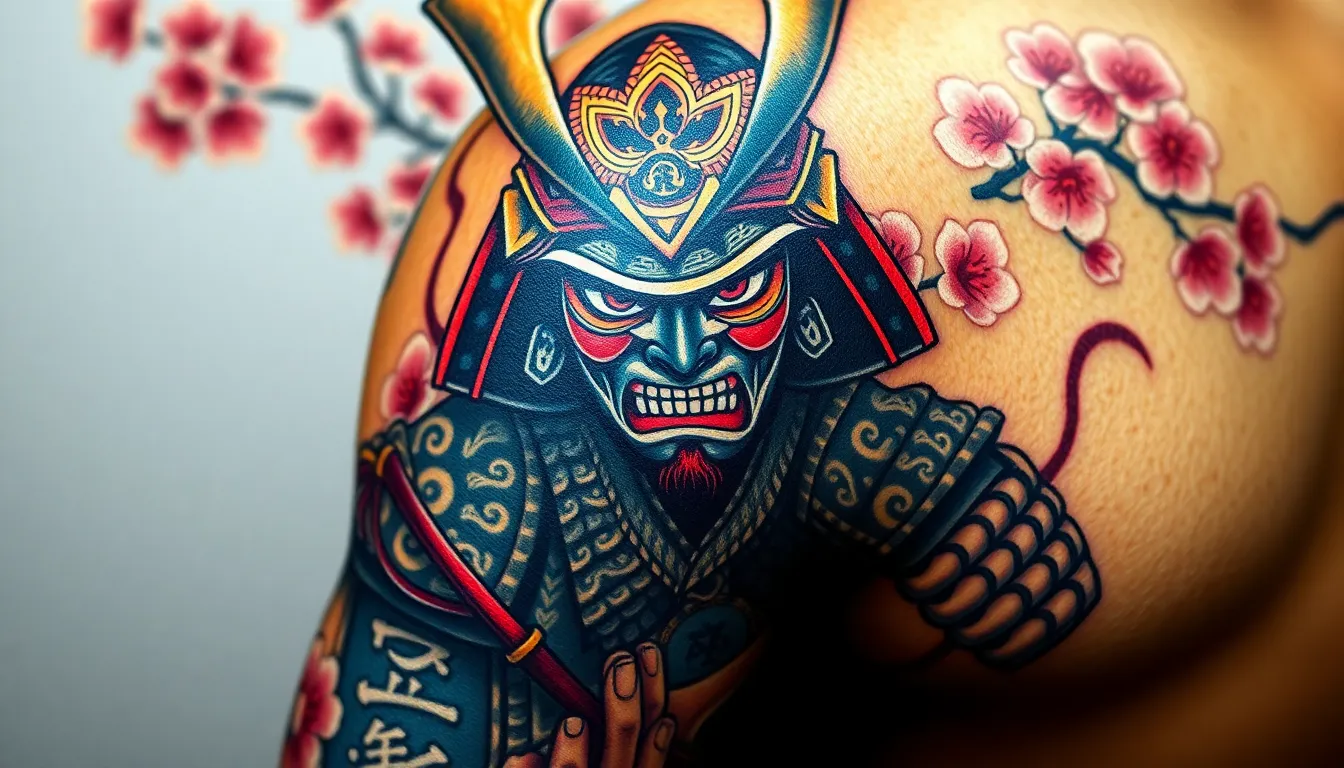
Warriors of ancient Japan represent honor, strength, and unwavering dedication in tattoo artistry. These designs capture the essence of bushido through detailed armor, fierce battle scenes, and iconic ceremonial elements.
Full Armor Samurai Portraits
Traditional armor portraits showcase intricate metalwork and decorative elements that define classic Japanese tattooing. Artists emphasize the detailed craftsmanship of traditional plates, scales, and protective gear through vivid colors or sophisticated shading techniques. Shoulder positioning allows the warrior’s presence to dominate the upper arm while flowing naturally into complementary elements below.
Color applications range from deep burgundy and gold accents to monochromatic approaches that highlight texture and form. Ceremonial crests and family symbols often appear on the chest plates, adding personal significance to the design. Background elements like cherry blossoms or temple architecture provide cultural context without overwhelming the central figure.
Battle Scene Compositions
Ever-changing battle scenes capture samurai in moments of intense combat, emphasizing their legendary martial prowess and battlefield courage. These compositions typically feature multiple warriors engaged in fierce encounters, with flowing robes and raised weapons creating powerful visual movement across the sleeve.
Symbolic integration enhances these scenes through carefully placed koi fish swimming upstream, representing perseverance in the face of adversity. Dragons weaving through the combat add spiritual protection and divine intervention to the narrative. Environmental details like swirling mists, scattered petals, or rocky terrain ground the scene in authentic Japanese landscapes.
Compositional flow guides the viewer’s eye from the shoulder down to the wrist, creating a cohesive story that unfolds with each viewing angle.
Helmet and Mask Focus Designs
Iconic helmet designs serve as powerful focal points that represent rank, clan affiliation, and warrior identity in Japanese sleeve tattoos. These pieces emphasize the distinctive silhouettes of kabuto helmets with their curved plates, elaborate crests, and protective neck guards.
Menacing masks capture the psychological warfare aspect of samurai culture, featuring fierce expressions meant to intimidate enemies and inspire allies. Detailed metalwork patterns and decorative elements like feathers, horns, or spiritual symbols add layers of meaning to these designs. Placement strategies position these elements at the shoulder or forearm where their impact is most dramatic.
Artistic variations include weathered battle worn appearances that tell stories of countless conflicts, or pristine ceremonial versions that emphasize honor and tradition.
Phoenix Japanese Sleeve Tattoo Inspirations
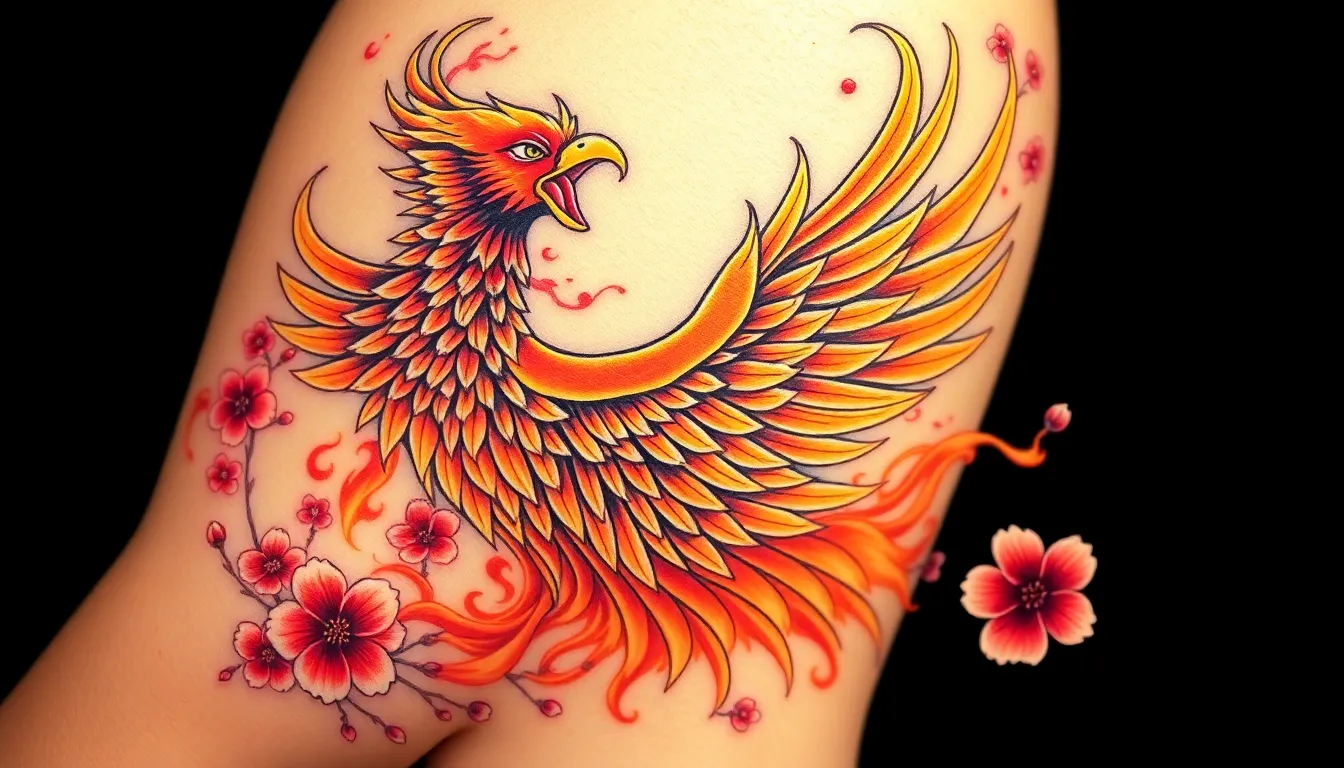
Phoenix designs bring profound symbolism to Japanese sleeve tattoos, representing transformation and eternal renewal. These majestic creatures create powerful visual narratives that complement the flowing nature of sleeve compositions.
Rising from Flames Imagery
Rising from flames designs showcase the Hō-ō’s most powerful symbolic element, emphasizing rebirth and immortality. The Japanese Phoenix emerges from blazing fire, creating dramatic compositions that highlight themes of resilience and transformation. Ever-changing poses capture the bird’s ascension, with flames swirling around its form to emphasize the cyclical nature of death and rebirth.
Vibrant colors dominate these designs, featuring intense oranges, deep reds, and golden yellows that bring the flames to life. Artists often position the phoenix at the center of the sleeve, allowing the flame elements to flow naturally around the arm’s contours. This composition creates movement and energy that draws the eye upward, symbolizing personal growth and triumph over adversity.
Wing Span Across the Arm
Wing span compositions use the sleeve’s full surface area, stretching the phoenix’s majestic wings across the entire arm. This approach creates visually striking designs that emphasize the bird’s ethereal presence and divine nature. The broad wingspan allows for intricate feather details and flowing lines that follow the arm’s natural curves.
Traditional Japanese styles feature bold outlines and stylized forms, while neo-traditional approaches blend classic elements with modern artistic techniques. Realism styles focus on lifelike details, capturing every feather texture and wing membrane with precision. Each style variation offers different aesthetic possibilities, from powerful graphic statements to delicate artistic masterpieces.
Mythical Bird Color Palettes
Color schemes for Japanese Phoenix tattoos traditionally feature vibrant plumage in shades of red, orange, and yellow, signifying the bird’s divine and groundbreaking nature. These warm tones create striking contrasts against darker background elements and enhance the tattoo’s visual impact. Gold accents often highlight exact feather details, adding luminosity and emphasizing the phoenix’s celestial origins.
Complementary elements like cherry blossoms can enhance cultural authenticity while adding depth to the overall design. Incorporating clouds, waves, or celestial bodies further enriches the tattoo’s symbolic meaning and creates cohesive visual narratives. Personalized color choices allow wearers to reflect their own experiences of growth and renewal, making each phoenix sleeve uniquely meaningful.
Geisha Japanese Sleeve Tattoo Designs
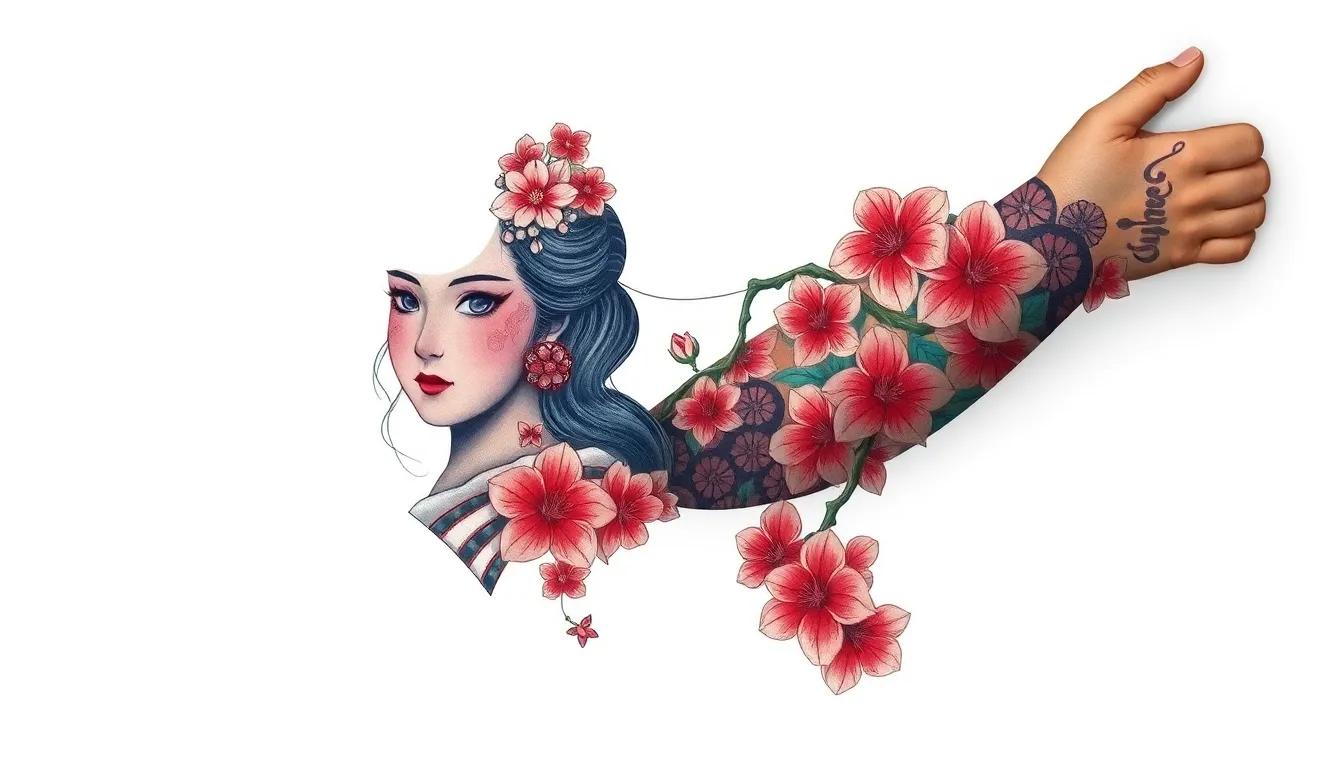
Geisha designs bring elegance and cultural depth to Japanese sleeve tattoos, representing refinement and artistic beauty. These sophisticated portraits showcase traditional Japanese femininity through intricate details and symbolic elements.
Traditional Geisha Portraits
Classic geisha portraits serve as stunning centerpieces for sleeve designs, featuring elaborate makeup and traditional styling that captures the essence of these iconic cultural figures. Artists often position these portraits on the upper arm or shoulder area, allowing ample space for facial details and expression work.
Detailed facial features require skilled craftsmanship, with white face paint, red lips, and decorative eye makeup creating the authentic geisha appearance. Shading techniques emphasize the porcelain-like skin quality while maintaining the delicate beauty these figures represent.
Hair ornaments and accessories add layers of complexity to geisha portraits, including decorative combs, pins, and seasonal flowers that reflect traditional Japanese aesthetics. These elements often extend beyond the portrait itself, creating flowing designs that integrate seamlessly with surrounding tattoo elements.
Kimono Pattern Details
Intricate kimono designs transform the sleeve into a canvas for traditional Japanese textile patterns, incorporating geometric shapes, floral motifs, and seasonal themes. Waves, clouds, and cherry blossoms frequently appear in these patterns, each carrying exact cultural meanings and seasonal associations.
Textile texture representation challenges tattoo artists to recreate the visual depth and richness of actual fabric through careful shading and line work. Bold patterns like asanoha (hemp leaf) or seigaiha (blue ocean waves) create striking visual impact while maintaining cultural authenticity.
Seasonal motif integration allows kimono patterns to tell stories through their imagery, with spring cherry blossoms, summer fireworks, autumn maple leaves, and winter snow scenes creating narrative depth. These patterns often wrap around the arm, creating movement and flow that follows the natural contours of the body.
Fan and Flower Accessories
Decorative fans serve as elegant additions to geisha sleeve designs, often positioned to create balance and visual interest within the overall composition. Folding fans and rigid fans each offer different aesthetic possibilities, with intricate patterns and seasonal artwork adorning their surfaces.
Cherry blossom integration enhances geisha designs through delicate petals that seem to drift around the portrait, symbolizing the fleeting nature of beauty and life. Pink and white blossoms create soft contrast against darker background elements while maintaining the feminine elegance of the overall design.
Seasonal flower combinations allow for personalized storytelling through exact blooms like peonies for honor, chrysanthemums for longevity, and lotus flowers for purity. Artists strategically place these floral elements to create natural flow and movement throughout the sleeve composition.
Water lily and pond elements complement geisha designs by creating serene backgrounds that emphasize tranquility and reflection. Rippling water effects and floating petals add depth while maintaining the peaceful atmosphere these designs traditionally convey.
Tiger Japanese Sleeve Tattoo Variations
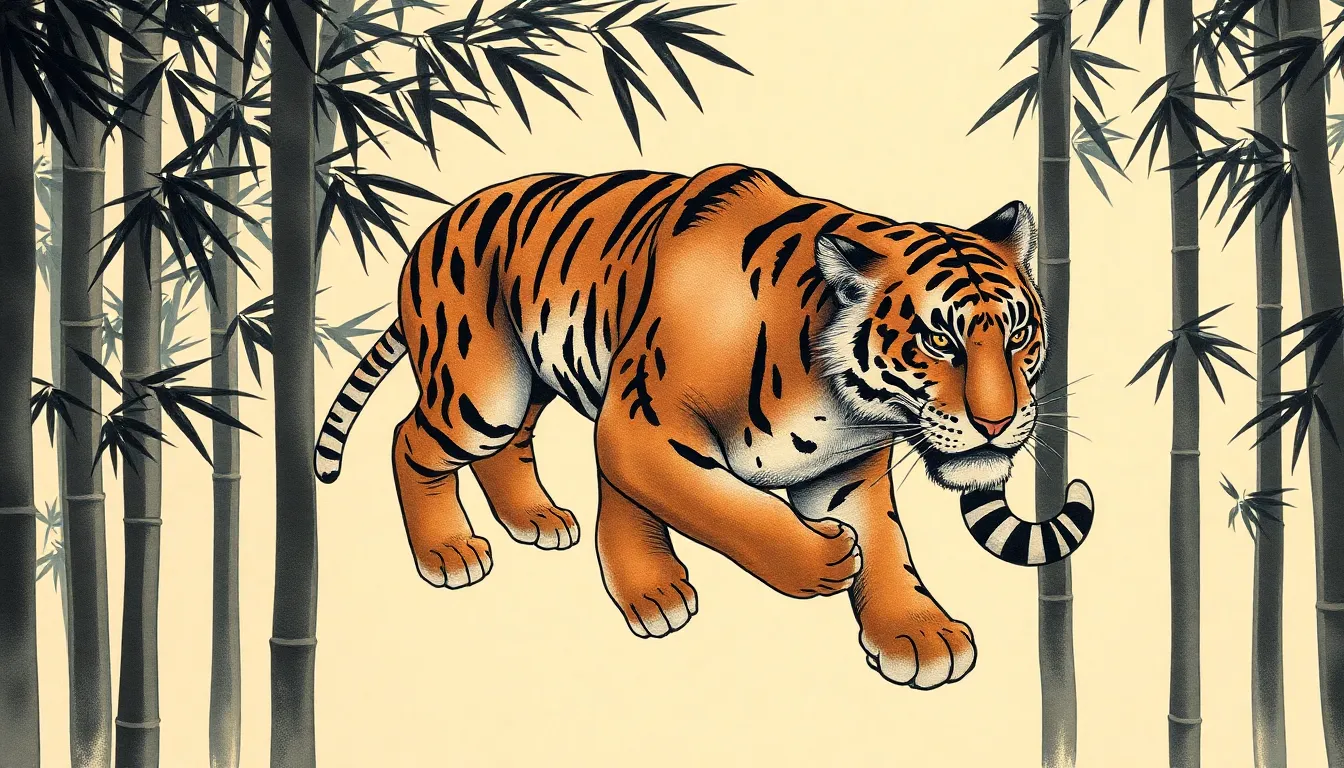
Tigers bring fierce power and untamed strength to Japanese sleeve tattoos, representing courage and protection in traditional Japanese culture. We’ll explore the most compelling tiger variations that create stunning sleeve compositions.
Prowling Tiger Poses
Prowling tiger poses capture stealth and controlled power in ever-changing compositions that showcase the animal’s natural hunting instincts. Artists position these tigers in crouched stances with muscles tensed and eyes focused, creating dramatic focal points that command attention across the entire sleeve. We see tigers depicted mid stride with one paw raised, emphasizing their graceful yet deadly movement through natural environments.
Side profile prowling positions allow tattoo artists to showcase the tiger’s distinctive stripes and muscular definition along the arm’s natural curves. These poses typically feature tigers moving through their habitat with heads lowered and bodies coiled for action. Artists often incorporate subtle shadows beneath the tiger’s form to enhance the three dimensional effect and ground the creature within its environment.
Crouching tiger variations emphasize the animal’s readiness to strike, with hindquarters raised and front legs extended in preparation for a powerful leap. We find these poses particularly effective when combined with environmental elements that suggest the tiger’s natural hunting grounds. The tension captured in these positions creates visual energy that flows throughout the entire sleeve design.
Bamboo Forest Backgrounds
Bamboo forest backgrounds provide natural settings that complement the tiger’s wild nature while adding vertical elements that enhance the sleeve’s overall composition. Artists create dense bamboo groves with varying stalk heights and thicknesses to establish depth and perspective within the tattoo. We see bamboo depicted in different growth stages, from young shoots to mature stalks, symbolizing resilience and adaptability.
Shadowy bamboo silhouettes create atmospheric depth behind prowling tigers, allowing the main subject to stand out while maintaining environmental context. These backgrounds often feature bamboo leaves caught in wind, adding movement and life to static compositions. Artists use negative space between bamboo stalks to create pathways and clearings where tigers naturally move.
Layered bamboo compositions use multiple planes of bamboo forests to create complex backgrounds that don’t overwhelm the tiger motif. We observe how artists vary the bamboo’s density and detail level based on distance, with foreground stalks showing intricate texture while background elements remain more impressionistic. This technique maintains focus on the tiger while providing rich environmental storytelling.
Wind and Motion Effects
Wind effects transform static tiger poses into ever-changing compositions that capture the raw power of nature in motion. Artists incorporate swirling wind patterns around the tiger’s form, using curved lines and flowing elements to suggest invisible forces at work. We see wind depicted through the tiger’s fur being blown back, creating texture and movement that brings the entire sleeve to life.
Motion blur techniques add kinetic energy to prowling tigers by suggesting rapid movement through subtle line work and shading gradients. Artists achieve this effect by extending certain elements of the tiger’s form while keeping others sharp and defined. These techniques work particularly well when combined with environmental elements like scattered leaves or grass being disturbed by the tiger’s passage.
Atmospheric wind patterns create invisible currents that connect different elements within the sleeve composition, unifying tigers with their bamboo forest environments. We find these effects most successful when they follow natural flow patterns that complement the arm’s contours. Artists often use wind to carry symbolic elements like cherry blossom petals or bamboo leaves across the design, creating narrative connections between different tattoo components.
Cherry Blossom Japanese Sleeve Tattoo Styles
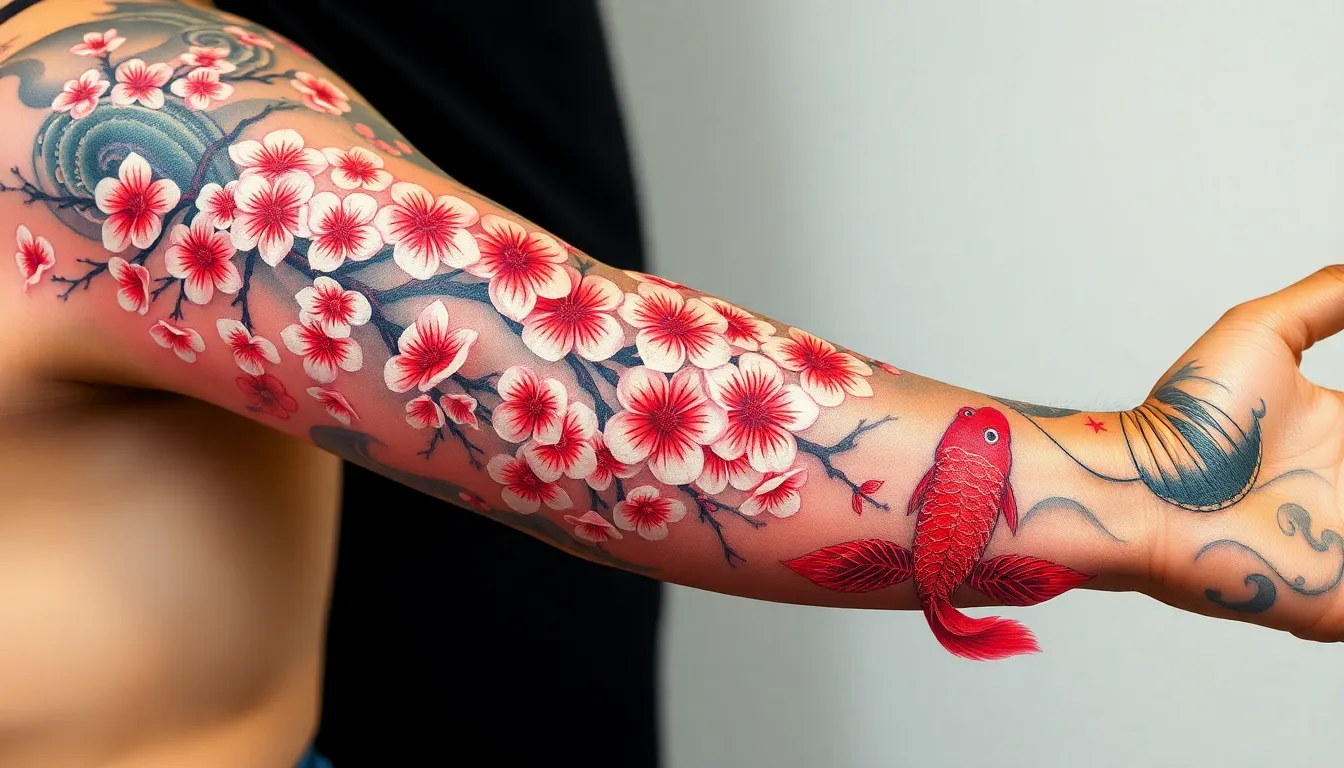
Cherry blossoms represent life’s fleeting beauty in Japanese culture, making them perfect centerpieces for sleeve tattoos. These delicate flowers create stunning visual narratives when combined with traditional Japanese artistic elements.
Full Bloom Branch Designs
Creating breathtaking displays, full bloom branch designs showcase cherry blossoms at their peak beauty, with intricate petals cascading along extended branches that follow your arm’s natural contours. Artists position these branches strategically to create harmony between the flowers and complementary elements like wind patterns or cloud formations. Detailed shading techniques bring depth to each petal, while the branches themselves become artistic storytelling devices that connect different sections of your sleeve design.
Symbolizing life’s precious moments, these designs capture the essence of spring’s renewal and growth. Traditional Japanese artistry emphasizes the organic flow of branches, creating movement that guides the viewer’s eye throughout the composition. Complementary motifs like koi fish swimming beneath blooming branches or dragons weaving through the floral elements enhance the overall narrative of your tattoo.
Falling Petals Animation
Capturing ever-changing movement, falling petals animation creates emotional depth by showing cherry blossoms in transition, symbolizing change and the passage of time through carefully placed petal clusters that appear to drift across your skin. Movement becomes the focal point as artists use varying petal sizes and orientations to suggest wind patterns and natural flow. Strategic placement of falling petals can connect different design elements within your sleeve, creating visual bridges between larger motifs.
Emphasizing life’s transient nature, this style allows for creative interpretation of personal transformation stories. Gradual fading techniques make petals appear to dissolve into the background, while concentrated clusters create focal points that draw attention to exact areas of your design. Integration with traditional elements like waves or clouds adds layers of meaning to the falling petal narrative.
Seasonal Tree Representations
Depicting cherry blossom trees across different seasons creates compelling storytelling opportunities, from spring blooms to autumn transformations, allowing your sleeve to represent personal growth cycles and life’s continuous changes. Seasonal variations showcase the tree’s complete lifecycle, with bare winter branches leading to spring buds, full summer foliage, and autumn colors. Artistic transitions between seasons create natural divisions within your sleeve design while maintaining overall cohesiveness.
Representing personal narratives, seasonal trees allow for customization that reflects your own life experiences and growth phases. Traditional Japanese seasonal motifs like snow on branches or autumn leaves enhance the cultural authenticity of your design. Storytelling potential expands when seasonal elements interact with other Japanese motifs, creating rich tapestries that evolve as viewers examine different sections of your sleeve tattoo.
Wave and Water Japanese Sleeve Tattoo Patterns
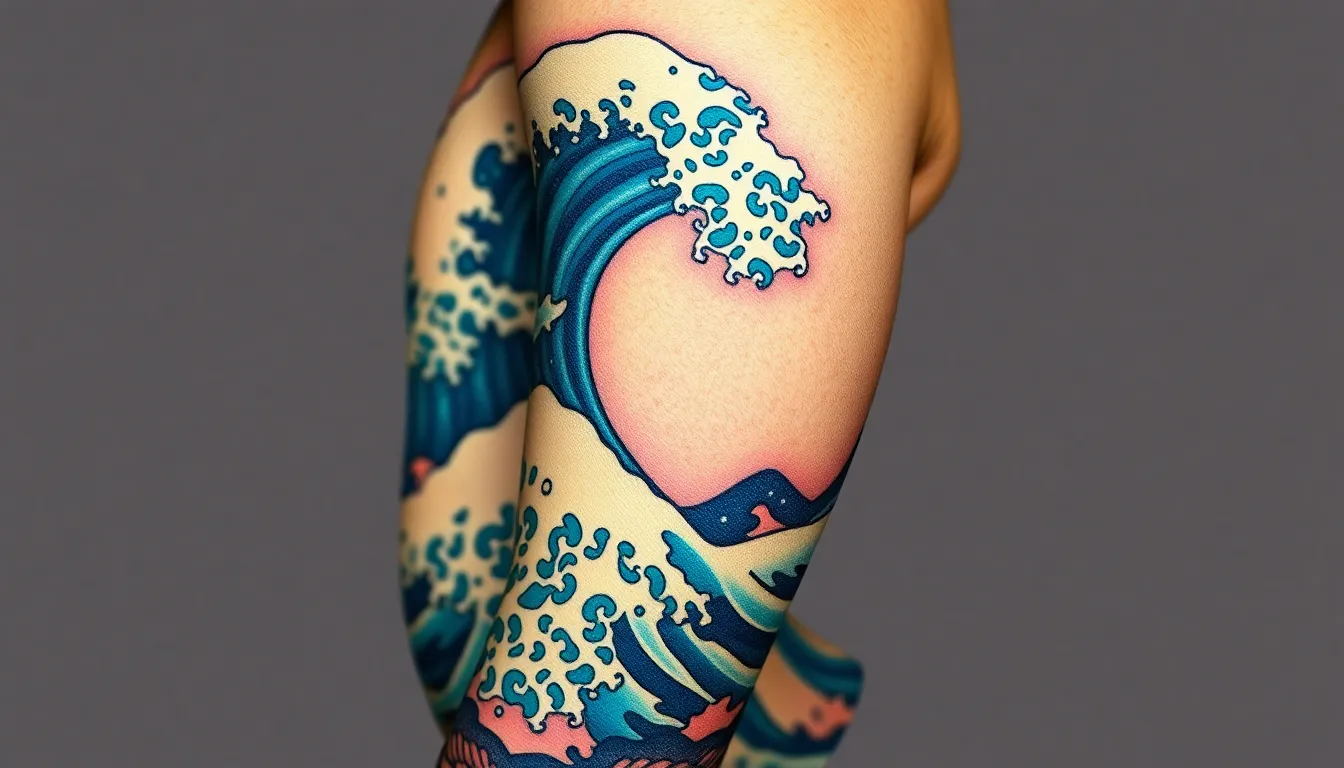
Wave and water elements create some of the most visually stunning Japanese sleeve tattoos, drawing from centuries of artistic tradition and natural symbolism. These flowing designs capture the power and beauty of water in all its forms.
Great Wave Hokusai Inspired Designs
Great Wave designs transform Hokusai’s iconic “The Great Wave off Kanagawa” into powerful sleeve centerpieces that symbolize strength and resilience. We see these compositions featuring bold, ever-changing curves that cascade across the entire arm, creating dramatic visual impact through traditional Japanese art techniques merged with modern tattooing styles. Artists create these waves with thick, flowing lines that emphasize the water’s tremendous force and movement.
Powerful wave crests dominate these designs, often positioned at the shoulder or forearm to maximize their visual prominence. The foam and spray details require intricate linework that demonstrates the artist’s technical skill while maintaining the design’s emotional intensity. Colors typically range from deep blues and teals to stark black and gray combinations that enhance the wave’s dramatic presence.
Multiple wave layers create depth and movement throughout the sleeve composition. Each wave connects seamlessly to surrounding elements like wind patterns or marine life, establishing a cohesive narrative that flows naturally around the arm’s contours.
Ocean Storm Compositions
Ocean storm sleeves incorporate turbulent waves, swirling winds, and dramatic cloud formations that reflect nature’s raw power and personal struggles. We design these compositions to capture the chaotic beauty of maritime storms through layered elements that create visual tension and movement. Wind lines sweep across the design, connecting wave crests to cloud formations above.
Stormy skies provide dramatic backgrounds that enhance the overall composition’s emotional weight. Lightning bolts occasionally pierce through the design, adding electric energy that symbolizes sudden change or revelation. Dark, brooding colors dominate these pieces, with strategic highlights that illuminate key focal points.
Turbulent water effects showcase the ocean’s unpredictable nature through overlapping wave patterns and foam spray details. These elements represent endurance through difficult times, making storm compositions particularly meaningful for those who’ve overcome important challenges. Rain elements connect sky and sea, creating unified compositions that tell complete stories of natural force.
Flowing Water Movement
Flowing water designs capture the gentle, continuous movement of streams and rivers through organic curves that follow the arm’s natural anatomy. We create these patterns using smooth, uninterrupted lines that suggest water’s fluid journey from source to destination. Natural elements like koi fish, lotus flowers, or river stones integrate seamlessly within the flowing current.
Ripple effects spread outward from central focal points, creating concentric circles that add rhythm and visual interest to the overall design. These subtle details demonstrate water’s groundbreaking power while maintaining the composition’s serene, meditative quality. Current lines guide the viewer’s eye around the sleeve, establishing natural viewing paths that enhance the design’s storytelling potential.
Stream patterns weave between other tattoo elements, creating transitions that connect different design sections harmoniously. Water droplets and splash effects add textural variety without overwhelming the design’s peaceful flow. These tattoos symbolize life’s constant change and adaptation, making them perfect choices for those embracing personal transformation or new life phases.
Oni Demon Japanese Sleeve Tattoo Ideas
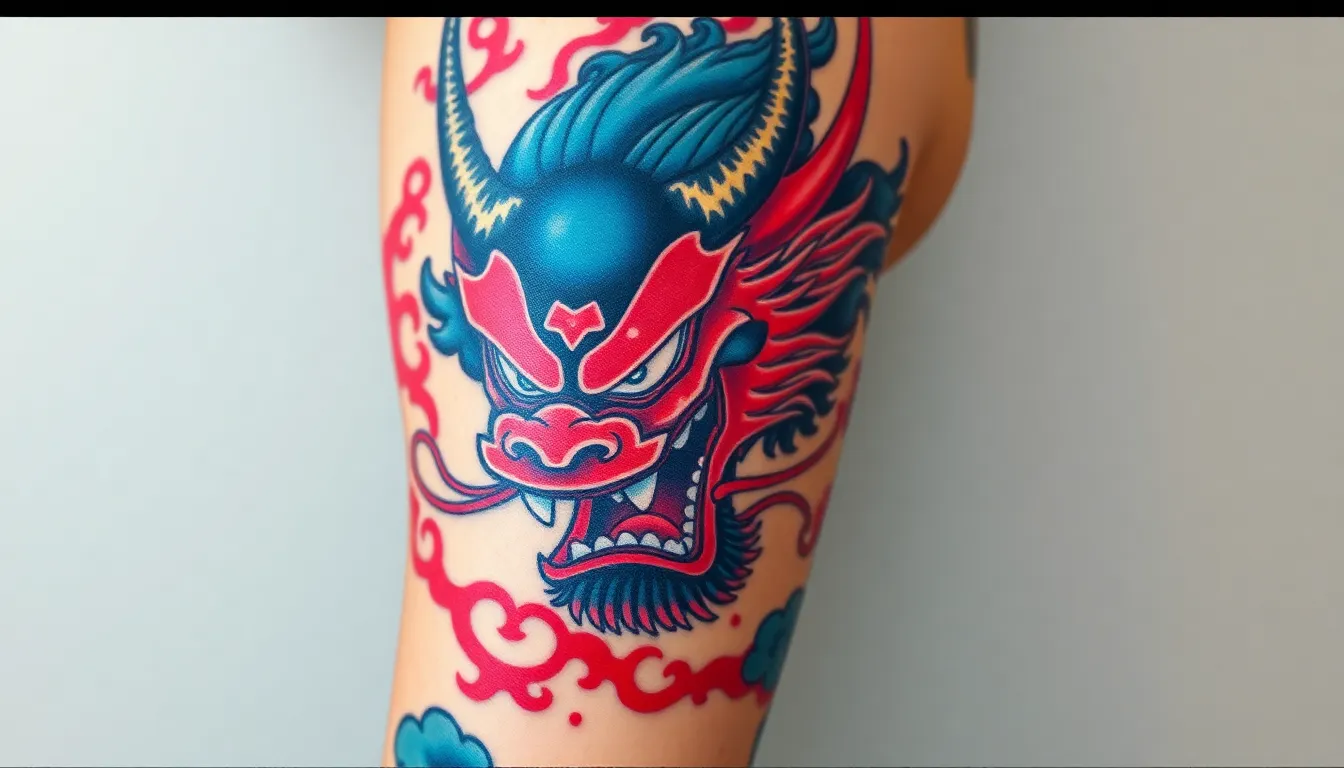
Oni demons represent fierce supernatural beings in Japanese folklore, bringing powerful energy and intimidating presence to sleeve tattoo designs. These malevolent spirits offer bold artistic opportunities that contrast beautifully with traditional Japanese motifs.
Traditional Mask Designs
Oni masks serve as commanding focal points for Japanese sleeve tattoos, drawing from centuries of theatrical and spiritual traditions. We see these designs feature exaggerated facial expressions with wide, menacing eyes and snarling mouths that convey raw power. Theater masks showcase intricate details like raised eyebrows, deep wrinkles, and pronounced cheekbones that create dramatic shadows within the composition.
Red and blue colorations dominate traditional oni mask designs, with red representing anger and passion while blue signifies cunning and supernatural wisdom. Artists incorporate these masks into larger sleeve compositions by positioning them at strategic focal points like the shoulder or forearm. Festival mask interpretations draw inspiration from Japanese cultural celebrations, featuring ornate decorative elements and stylized features that honor traditional craftsmanship.
Placement strategies for oni masks consider the arm’s natural contours to maximize visual impact and create ever-changing viewing angles. We recommend integrating surrounding elements like flames, smoke, or lightning to enhance the mask’s supernatural presence. Modern interpretations blend traditional features with contemporary artistic techniques, creating unique variations that maintain cultural authenticity while expressing personal style.
Full Body Demon Illustrations
Complete oni demon figures transform entire sleeves into powerful supernatural narratives that showcase the creature’s imposing physical presence. These illustrations capture demons in various ever-changing poses, from aggressive combat stances to contemplative seated positions that reveal different aspects of their complex nature. Muscular anatomy receives careful attention, with artists emphasizing the oni’s supernatural strength through detailed rendering of powerful limbs and torso.
Standing demon compositions typically position the oni as the sleeve’s central figure, surrounded by complementary elements like swirling clouds, rocky landscapes, or temple architecture. Sitting poses offer opportunities for more intricate background work, allowing artists to incorporate detailed environmental elements that tell broader stories. Action scenes depict oni engaged in battle or wielding traditional weapons like clubs and swords, creating ever-changing movement throughout the design.
Size and proportion considerations ensure that full body demon illustrations maintain proper scale relationships with other sleeve elements. We observe successful designs balance the oni’s commanding presence with supporting motifs like cherry blossoms or waves that provide visual relief. Color schemes often emphasize the demon’s otherworldly nature through bold reds, deep purples, and stark contrasts that make the figure stand out dramatically.
Horn and Fang Details
Prominent horns create striking silhouettes that immediately identify oni demons within Japanese sleeve compositions, serving as distinctive markers of supernatural power. Artists render these features with varying textures, from smooth polished surfaces to rough, weathered appearances that suggest age and battle experience. Multiple horn configurations include single central horns, paired symmetrical horns, or elaborate multi pronged arrangements that create complex geometric patterns.
Sharp fangs and teeth receive meticulous attention to detail, with artists using highlighting and shading techniques to emphasize their razor sharp edges and threatening appearance. We notice successful designs incorporate saliva drops, blood stains, or other visceral elements that enhance the demon’s menacing presence. Tooth arrangements vary from prominent canine fangs to full sets of pointed teeth that create frightening grimaces.
Integration with facial features ensures that horns and fangs complement the overall demon design rather than overwhelming other important elements. Shading techniques create depth and dimension, making these features appear to emerge naturally from the oni’s skull and jawline. Metal accents or decorative bands around horns add cultural authenticity while creating additional visual interest that catches light and draws attention to these powerful symbolic elements.
Snake Japanese Sleeve Tattoo Concepts
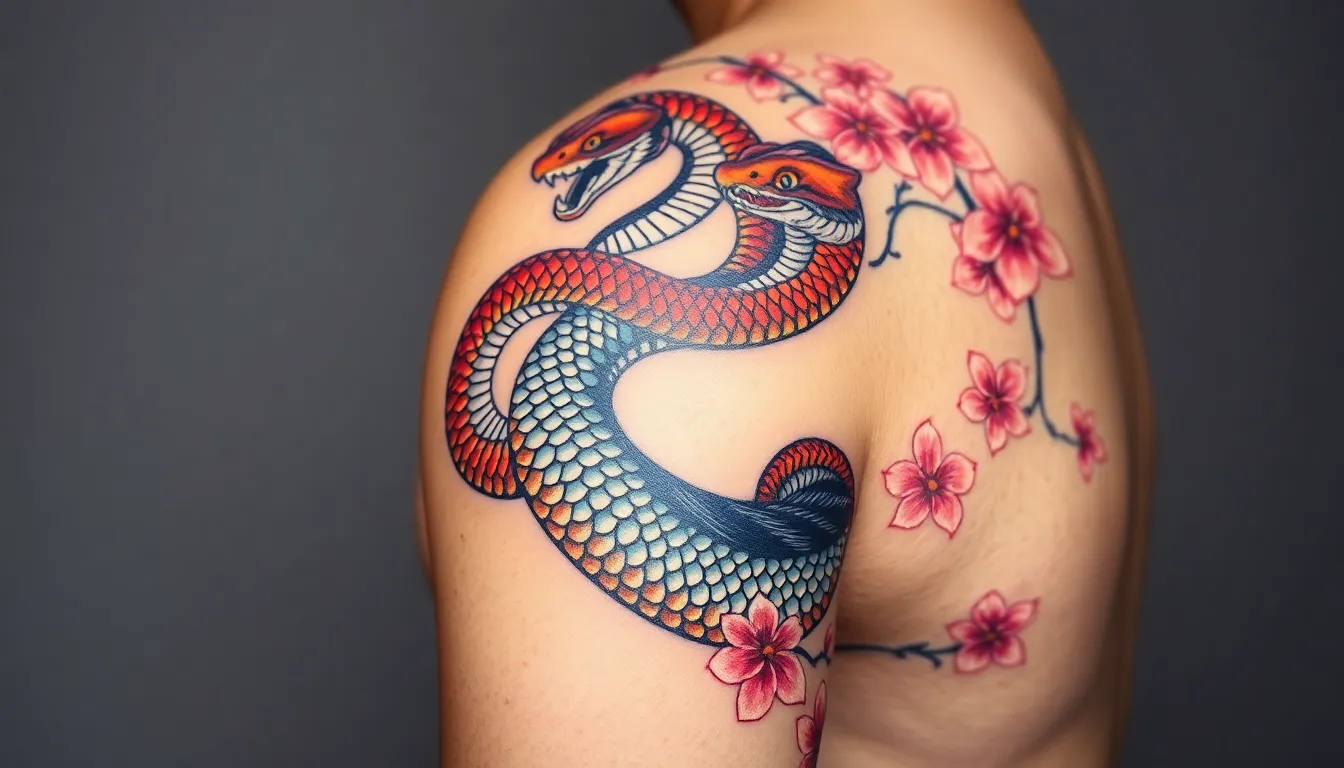
Snake designs bring powerful spiritual energy to Japanese sleeve tattoos through their deep cultural symbolism and striking visual appeal. These serpentine motifs create compelling narratives that flow naturally across the arm’s contours.
Coiled Serpent Arrangements
Coiled serpent designs showcase the snake’s natural flexibility while maximizing the sleeve’s visual impact. Artists position these serpents to wrap around the arm or other body parts in fluid motions that create mesmerizing compositions. Traditional arrangements feature the snake’s body spiraling from shoulder to wrist, allowing the design to follow the arm’s natural muscle structure.
Ever-changing coiling patterns emphasize the snake’s protective nature while maintaining visual balance throughout the sleeve. Master tattoo artists often incorporate multiple coils that intersect at strategic points, creating depth and movement within the design. Popular arrangements include ascending spirals that symbolize personal growth and descending patterns that represent grounding energy.
Scale Texture Techniques
Scale texture techniques transform snake tattoos into realistic masterpieces through careful attention to detail and shading. Traditional Japanese tattooing, known as Irezumi, emphasizes vibrant colors and detailed shading to create lifelike serpent scales. Artists use various gradation methods to achieve the three-dimensional appearance that makes scales appear to shimmer and move.
Modern practitioners employ multiple needle configurations to create different scale patterns, from fine diamond shapes to larger hexagonal formations. Color variations within individual scales add authenticity, with darker edges and lighter centers creating natural depth. Highlighting techniques bring scales to life by simulating how light reflects off real serpent skin.
Mythical Snake Symbolism
Mythical snake symbolism in Japanese culture centers on protection and good fortune, making these designs particularly meaningful for sleeve tattoos. Snakes are believed to offer spiritual protection while bringing prosperity to their bearers, reflecting ancient Japanese beliefs about serpentine guardians.
Transformation and wisdom represent core symbolic elements that resonate with people seeking personal growth or overcoming life challenges. Cultural integration occurs when artists combine snake motifs with other Japanese elements like cherry blossoms or koi fish, adding layers of meaning to the overall composition.
Spiritual significance varies based on the snake’s position and accompanying elements, with upward-facing serpents symbolizing ascension and horizontal arrangements representing balance. Contemporary interpretations often blend traditional symbolism with personal meaning, creating unique narratives that reflect individual journeys and aspirations.
Conclusion
Japanese sleeve tattoos represent one of the most sophisticated forms of body art available today. We’ve explored how these designs seamlessly blend cultural heritage with personal expression through powerful symbols like dragons koi fish samurai warriors phoenixes geishas tigers cherry blossoms waves oni demons and serpents.
Each element carries deep meaning while contributing to a cohesive visual narrative that flows naturally across your arm. The versatility of Japanese tattooing allows for endless customization whether you’re drawn to the wisdom of dragons the perseverance of koi or the fierce protection of oni demons.
These timeless designs continue to captivate tattoo enthusiasts worldwide because they offer both stunning aesthetics and profound symbolism. Your Japanese sleeve tattoo will tell your unique story while honoring centuries of artistic tradition.
Frequently Asked Questions
What makes Japanese sleeve tattoos culturally significant?
Japanese sleeve tattoos combine intricate designs with deep cultural symbolism, featuring mythical creatures and natural elements that tell cohesive stories. Each motif carries specific meanings rooted in Japanese folklore and tradition, creating visually striking artwork that represents personal narratives of transformation, strength, and spiritual growth.
What do dragon tattoos symbolize in Japanese culture?
Dragons in Japanese tattoos represent wisdom, strength, and protection. Ascending dragons symbolize personal growth and triumph, while different colors carry specific meanings: black for wisdom, red for passion, blue for tranquility, green for growth, and gold for imperial power.
Why are koi fish popular in Japanese sleeve tattoos?
Koi fish symbolize perseverance and good fortune, making them powerful centerpieces for sleeve designs. Swimming upstream koi represent strength and determination, while their integration with water elements like ripples and waves enhances the visual narrative of overcoming obstacles.
What do samurai warrior tattoos represent?
Samurai designs embody honor, strength, and dedication. These tattoos showcase intricate armor details, battle scenes, and symbolic helmet designs that represent warrior identity and psychological warfare, telling stories of honor, conflict, and unwavering commitment to one’s principles.
What is the meaning behind phoenix tattoos?
Phoenix designs represent transformation, rebirth, and eternal renewal. Rising from flames imagery emphasizes immortality and resilience, while vibrant colors like oranges, reds, and golden yellows create dramatic compositions that symbolize overcoming adversity and personal growth.
How do geisha tattoos contribute to Japanese sleeve designs?
Geisha designs bring elegance and cultural depth, representing refinement and artistic beauty. They feature intricate details like elaborate makeup, hair ornaments, and kimono patterns that reflect traditional Japanese aesthetics and celebrate the artistry of Japanese culture.
What do tiger designs symbolize in Japanese tattoos?
Tigers represent courage and protection in Japanese culture. Various poses like prowling and crouching capture the animal’s strength and hunting instincts, often set against bamboo forest backgrounds that symbolize resilience and add natural depth to the composition.
Why are cherry blossoms significant in Japanese sleeve tattoos?
Cherry blossoms represent life’s fleeting beauty and the transient nature of existence. Full bloom branches and falling petals capture different life stages, creating perfect centerpieces that emphasize the Japanese philosophy of appreciating temporary beauty and life’s precious moments.
What role do wave and water elements play in Japanese tattoos?
Wave designs draw from centuries of artistic tradition, often inspired by Hokusai’s Great Wave. They symbolize strength, resilience, and life’s constant change, with ocean storms representing personal struggles and flowing water capturing gentle movement and adaptation.
What do oni demon tattoos represent?
Oni demons are fierce supernatural beings from Japanese folklore that add powerful energy to sleeve tattoos. Traditional oni masks with exaggerated expressions and vibrant colors convey raw power, while full-body illustrations create narratives of supernatural strength and protection.
How do snake designs enhance Japanese sleeve tattoos?
Snakes bring spiritual energy through their cultural symbolism, representing protection, good fortune, transformation, and wisdom. Coiled arrangements maximize visual impact while following arm contours, with detailed scale textures creating lifelike appearances that enhance the overall mystical narrative.
